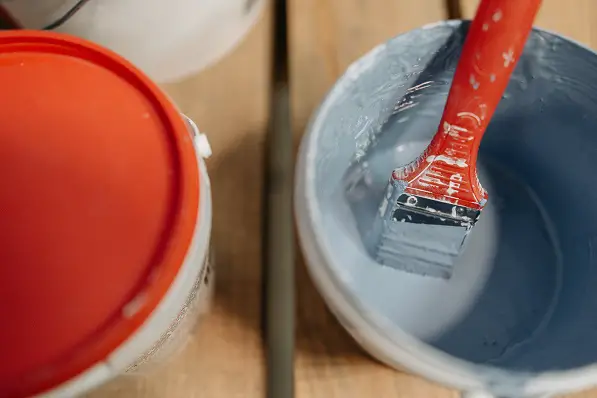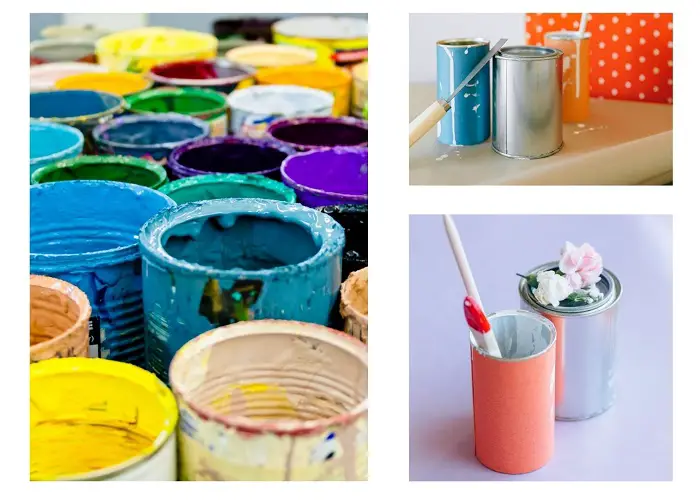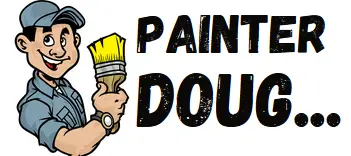
Cleaning a paint bucket after you are done with house painting can be tiring.
Most DIYers will often ignore the task and will end up wasting the bucket. But if you take some time to clean and remove the paint, you can reuse the same old bucket to mix up the paint colors or to hold the smaller paint cans.
For your next interior or exterior paint projects, you can even use this cleaned-up paint bucket to soak up the paint brushes. Or for storing the wet brushes when you want to come back and continue painting the next day.
So, make sure you spare a few minutes and clean the used paint bucket before it dries.
What's Here in the Article:
How to Clean Your Paint Bucket for Reuse?
Cleaning the paint off your bucket for reuse is important if you decide to mix up the paints. This will avoid contaminating the new paint.
After you have completed your paint project, you can follow these easy steps to wash your plastic paint bucket:
- Pour unused paint into the original paint can.
- Completely wipe down the bucket from inside as well as outside using a paper towel.
- Dispose of the towel carefully and wash the bucket with soapy water.
- Using clean cotton cloth and rubbing alcohol (turpentine or kerosene), clean the paint that may be left behind in the bucket.
- You may not need the solvent if it’s a water-based latex paint – water alone can do the job.
- But if it’s oil-based paint, using solvents to clean the paint is important.
- Once all the paint has been removed, rinse the bucket with soap and water again.

How to Remove Dried Paint from the Bucket?
If you haven’t wiped the wet paint off your plastic bucket, there will be dried paint still residing.
The time and effort needed to remove such dried paint will mostly depend on the type of paint you have used. If it’s the dried latex or acrylic paint (and not an oil-based paint) on your old dirty pail, it’s relatively easy and fast.
Mild solutions like isopropyl alcohol (70–90%) or soapy water with gentle scrubbing work well, especially when the acrylic paint is still fresh. For dried acrylic, Simple Green, Super Clean, or even WD-40 can help soften it without damaging the plastic.
For tougher paints like enamel or spray paint on plastic surfaces, more potent removers such as Citristrip, Goof Off Graffiti Remover (specifically the plastic-safe version), or Rust-Oleum Aircraft Remover (in small, cautious doses) are effective.
Avoid acetone or standard paint thinners unless you’re certain the plastic is resistant to them.
For dried water-based latex paint, follow these steps:
- Scrape away the dried latex paint with a dull knife or spatula.
- Soak a rag in rubbing alcohol and rub thoroughly over the leftover dried paint.
- Let the alcohol sit for a few minutes, and then, using a cloth remove the dried paint.
- Use a latex paint remover and a rag to remove any stubborn dried paint still left behind.
- Finally, rinse the bucket with soap, detergent, and warm water.
If you have access to a pressure washer, it can be an effective tool for removing dried water-based paints from a plastic bucket—just be sure to adjust the pressure settings to prevent any damage to the surface.
For smaller paint stains, you can also consider using sandpaper or a sanding block. Gently sand the affected areas, being careful not to apply too much pressure to avoid scratching the plastic.
Alternatively, you can opt for biodegradable paint strippers that are safe for plastic. These eco-friendly solutions are designed to break down paint without harming the surface—just make sure to follow the manufacturer’s instructions for proper application and removal.
For dried oil-based enamel paint, you will need to follow these steps:
- Scrub off the dried enamel paint with a dull knife, spatula, or a sandpaper.
- Soak a rag in a paint stripper, lacquer thinner, or acetone – rub thoroughly over the leftover dried paint.
- Let the stripper solution sit for a few minutes, and then remove the dried paint.
- Finally, rinse your plastic tub with soap, detergent, and warm water.
For dried oil-based paints, you may need to submerge your paint gallon bucket in the solution if the stubborn paint does not seem to come off easily.
Start by filling a basin or sink with warm water and adding a small amount of mild dish soap or vinegar to create a soapy solution.
Submerge your plastic bucket in this mixture, making sure all paint-stained areas are fully covered, and let it soak for at least 30 minutes to help loosen any remaining paint.
After soaking, use a soft-bristle brush or sponge to gently scrub the surface of the bucket, paying special attention to the stained areas. Continue scrubbing with light pressure until all the paint is removed.

Can You Recycle a Plastic Bucket with Old, Dried-out Paint?
Although there is a growing line of paint cans (typically made from steel), plastic-made buckets are mostly available when you buy the paint in larger quantities. Once the paint is fully removed, these will last for many years because of their hard, corrosion-resistant property.
For steel cans that have a tin coating, the ability to reuse them is a tempting prospect, assuming you can fully remove the dried paint residue inside. Remember, you can reuse them, again and again, thanks to the steel used in their construction which is mostly rust resistant.
What follows are ten creative ways to recycle and reuse the paint buckets and cans that you own.
1- Bug Feeders
You can create feeders with paint cans that resemble ladybugs or bumblebees with just a few colors of paint and some wings.
Use paint washers as the eyes, metal clothes netting, and hangers can be used to create the wings, and all you need is a pencil or dowel attached at the front for the birds to sit.
2- Flowers
If you have several paint pails and lids, you can create a unique flower design that makes the perfect outdoor decoration or one for your children’s room. Paint the lid with a flower design and then add small wooden dowels painted as the stems.
A transparent glass vase is a perfect way to display this unique flower design, which makes for the perfect decoration.
3- Hooks
If you are looking for creative hook designs to hang your jackets, sweaters, or coats, then you can use old paint cans to do the job.
Whether you choose to paint them and create bright, beautiful colors or leave them as they are stripped of the labels to show off a sheen, industrial appearance, they make the perfect hooks for your clothing.
In addition, you can store gloves, mittens, and other essential items in the cans themselves for use during the cold winter months.
4- Jewelry Box
Clean out the paint can, strip away the label, and paint flowers, ribbons, or pearls on the outside. This creates a nice jewelry box or tin that can be placed in your child’s room. Or, it makes a great gift for a new mom or bride.
They will love the care and attention you have put into decorating the new tin for their jewelry storage.
5- Lanterns
One of the most creative and simplest ways to reuse an old paint can is by turning it into a candle lantern.
All you need to do is punch some holes into the can by driving nails into it. You can create elaborate patterns that result in a remarkable design. Plus, you can use different colors of paint to create a decorative result.
Keep in mind that you can also use small LED lights of different colors as well. You will need a power source, but rechargeable batteries just might do the trick. Now you can create an unforgettable atmosphere for nighttime patio parties.
6- Mail Sorters
Paint tubs and cans make for great storage products, but they can also help you sort the mail you receive. This works especially well if you are running a home business. Clean out the cans, put a label on each to identify the category of person, and you have now organized your mail.
7- Mirrors
The paint can lid the perfect mirror holder. You can use a glass or acrylic mirror and spray paint it with colors such as peach or gold. Attach the mirror to the lid, and you have a wonderful reflective surface that can augment your room.
Glass mirrors are sharp enough to see yourself. And while acrylic mirrors tend to be duller and less sharp, they are cheap, lightweight, and easy to use for different reflective designs.
8- Planters
One of the easiest ways to recycle paint cans is by using them as hangable planters for flowers and plants. Since most paint cans already have a swinging handle, you just need to clean out the can, fill it with dirt and plant the flowers inside.
The tin coating will keep the can from rusting, although you can add another coat of paint to the exterior.
In addition to hanging the can, you can also screw it into a fence or wall to create a unique decoration of different planters for your yard.
9- Random Item Sorter
Everyone has a junk drawer where a random collection of items is kept. You can free up that drawer by using paint cans. Clean up the can and add a label to identify the contents. This is the perfect way to sort chargers, small tools, and the like.
10- Trash Cans
If you have larger paint buckets and cans, you can turn them into an office trash can or wastebasket. They are perfect when you need a small trash can for a room or office.
If you want to dress up, the paint can, find an attractive fabric and wrap it around as you would a rope. This adds some class and style to your new wastebasket.
When to Dispose Of the Old Empty Plastic Buckets and Paint Cans?
You should dispose of old empty plastic buckets and paint cans when they are no longer usable, too damaged to repurpose, or contain dried paint residues that can’t be cleaned effectively. Here are a few key signs and guidelines to help you decide when it’s time to toss them:
- Cracks or Structural Damage: If the bucket or can has cracks, holes, or broken handles that make it unsafe or impractical to use, it’s best to dispose of it.
- Stubborn Paint Residue: If dried paint inside the bucket or can cannot be removed despite soaking, scrubbing, or using cleaners, and it interferes with reuse, consider disposal.
- Rust or Corrosion (for metal cans): Rusty or corroded paint cans can be hazardous, especially if they’ve been exposed to moisture. These should be properly discarded.
- No Longer Needed: If you’ve completed all your painting projects and have no further use for the container, and it’s not suitable for storage or repurposing, it’s time to let it go.
Proper Disposal Tips – Where to Throw?
In general, you may throw away empty paint buckets in the recycling bins at the curb that can be picked up on the next trash day. But to do this, you will need to make sure that these containers are empty and do not hold any leftover hazardous paints or chemicals.
If there’s any paint left behind after the completion of your project, you can either pour it into another container for storage or can harden and dispose of it safely as hazardous waste.
Depending on the state you live in, collection points, schools, or community groups may be available that need the paint. You can consider donating the paint along with the HDPE pails there.
Based on the local waste management or city regulations, many of these High-Density Polyethylene (HDPE) made 5-gallon construction pails can then be recycled and reused for making various other products.
The overall disposal of and recycling process of these industrial and commercial products benefits by reducing their impact on our environment in terms of pollution.
Final Thoughts
Cleaning the painter’s bucket is relatively easy if it’s still wet. However, the time and paint removal products you will need will depend on the type of paint you have used – whether oil-based or latex paint.
Just make sure you use the right products and follow the correct steps before the paint gets dried. Also test the paint remover on a hidden spot first, as many strong removers contain solvents that can soften or warp plastic.
Overall, patience and gentle scraping with a plastic putty knife or toothbrush will help protect the surface during removal. It can save you a lot of money if you plan to reuse this plastic bucket in the future.
Share the post "How to Remove Dried Paint from a Plastic Bucket?"

Douglas Becker (aka Painter Doug) has over twenty years of experience as a painter in Adkins, Texas. At present, he resides in Florida with his family.
From painting multi-storeyed houses, condos, and apartments to large commercial buildings and small offices, he had served various customers in areas not only in Adkins but also in Southwest Florida, Sarasota, Naples, and many more. To know more about him check here.




